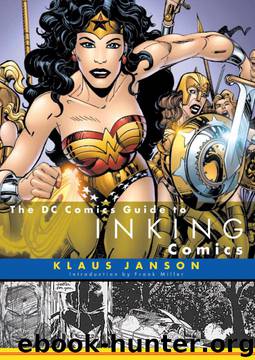The DC Comics Guide to Inking Comics by Janson Klaus

Author:Janson, Klaus [Janson, Klaus]
Language: eng
Format: epub
Tags: Reference
ISBN: 9780823010295
Publisher: Watson-Guptill
Published: 2003-07-17T04:00:00+00:00
Different inkers have different approaches to similar problems. Compare the face of Green Arrow inked by Dick Giordano in the bottom image to the top panel, where the very similar head is inked by Bill Sienkiewicz. The first panel is from Green Lantern #86 (November 1971), script by Dennis O’Neil and pencils by Neal Adams. The second panel is from Green Lantern Legacy (2002), script by Joe Kelly and pencils by Brent Anderson.
The opportunity to create good art in this environment is challenging but not impossible, even with the traditional assembly line approach. It is achievable not just through the vision of the penciller or inker, but primarily the editor. A savvy editor has the overall picture of a book in his or her head and hires the writer, penciller, inker and colorist to fulfill that picture. Mainstream comic books that have attained a level of greatness always have strong editors at the helm with a strong vision. DC editor Julie Schwartz is an example. His was the editorial vision that sewed together the individual pieces into a credible whole.
The assembly line method of producing comic books has nothing at all to do with the worth and value of the medium. Sequential art and film both run the gamut from the individual auteur to the collective communal effort. There may be questions about the artistic value and potential of monthly comic books but sequential art as a medium without any doubt deserves to be on the same level as all other art forms.
In the early days of comics, inkers were hired to mimic the style of the credited artists. Inkers worked for the penciller and often received no credit. There were even occasions when the credited artist never touched the paper that art was drawn upon. It was in the interest of the original artist and the character with which he was associated to maintain an identifiable look that became attached to his name. It was at this point that the notion of inkers as “tracers” took hold. Inkers were specifically brought on board based on their ability to adhere to a certain look.
As the fragmentation of artistic responsibilities became more prevalent, it was more difficult to pursue an individual vision. The system could no longer accommodate that need, and a different kind of inker was created—one that was no longer hired by the artist to mimic a particular style but rather an ink artist with his own individual and unique approach. Inkers became personalities with recognizable styles that were in demand in their own right separate from that of any penciller. This approach to the artistic relationship between the penciller and inker brought about a revolution in comic art. It was no longer necessary to rely on the strength of the penciller to produce good work. Instead, the best comic art became an amalgam of the two individual artists that resulted in the creation of a third style.
Download
This site does not store any files on its server. We only index and link to content provided by other sites. Please contact the content providers to delete copyright contents if any and email us, we'll remove relevant links or contents immediately.
Adulting by Kelly Williams Brown(4534)
Drawing Cutting Edge Anatomy by Christopher Hart(3485)
Figure Drawing for Artists by Steve Huston(3409)
Draw Your Day by Samantha Dion Baker(3319)
Drawing Shortcuts: Developing Quick Drawing Skills Using Today's Technology by Leggitt Jim(3037)
Make Comics Like the Pros by Greg Pak(2883)
Rapid Viz: A New Method for the Rapid Visualization of Ideas by Kurt Hanks & Larry Belliston(2870)
0041152001443424520 .pdf by Unknown(2815)
How The Mind Works by Steven Pinker(2777)
How Proust Can Change Your Life by Alain De Botton(2772)
Draw to Win: A Crash Course on How to Lead, Sell, and Innovate With Your Visual Mind by Dan Roam(2756)
Day by Elie Wiesel(2746)
Draw-A-Saurus by James Silvani(2687)
Tattoo Art by Doralba Picerno(2623)
Modern Cartooning by Christopher Hart(2588)
Learn Drawing Quickly by Sharon Finmark(2550)
Poses for Artists Volume 2 - Standing Poses: An essential reference for figure drawing and the human form. (Inspiring Art and Artists) by Justin Martin(2534)
Drawing and Painting Birds by Tim Wootton(2475)
Poses for Artists - Dynamic & Sitting: An essential reference for figure drawing and the human form (Inspiring Art and Artists Book 1) by Justin R Martin(2453)
